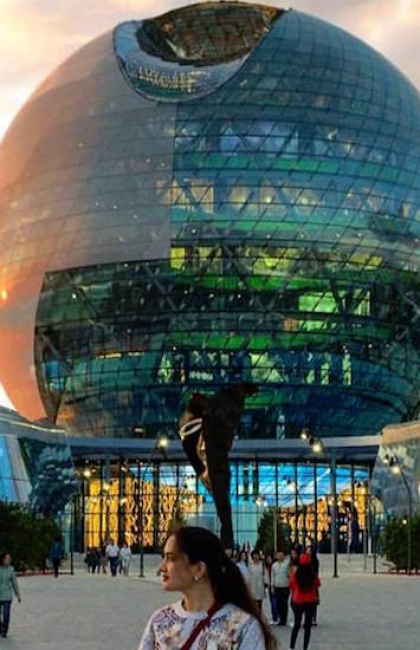Nur Alem Museum of Future Energy
Seen from afar
From a distance, Nur Alem Museum of Future Energy looks like a giant ball reflecting the sky. It is the largest building of its kind in the world and has become one of the most prominent attractions in Astana since its opening. The sphere was built as the central pavilion for the international specialized exhibition EXPO 2017, which focused on «Future Energy». Therefore, it is also known as the Museum of Future Energy.
Translated from Kazakh, Nur Alem means «Shining World». The pavilion was designed by an American architectural firm that also created famous skyscrapers like the Burj Khalifa in Dubai (UAE) and the Kingdom Tower in Jeddah (Saudi Arabia). The architect behind the project is Albert Speer Jr., who envisioned the Nur Alem sphere as the embodiment of the «last drop of oil» and the beginning of an era when people shift to renewable energy. Additionally, the sphere symbolizes the start of life and eternity.
During the EXPO, the Nur Alem sphere was Kazakhstan's pavilion, and it attracted hundreds of thousands of tourists from both Kazakhstan and abroad. It was the most visited attraction, with over 1.3 million visitors out of the four million total. Every evening, the sphere also hosted a grandiose laser show.
After the EXPO, the Nur Alem sphere became the Future Energy Museum, the first institution of its kind in the country. The museum offers excursions and open lessons for students and schoolchildren, in addition to lectures. The spherical building not only showcases different energy types but also generates energy. Solar panels are built into the walls, and two wind generators operate quietly at the top. The pavilion uses special glass that withstands the cold and winds of Astana.
Floor by floor
The Nur Alem sphere is 100 meters (328 ft) high and 80 meters (262 ft) in diameter, with eight floors, each with its theme and interactive exhibits showcasing different types of energy. Visitors can touch, experiment, and participate in scientific experiments. The first floor explores the culture and history of Kazakhstan and features modern developments by Kazakh scientists.
The second floor focuses on «Water Energy». The third floor is a hit with young visitors and explains kinetic energy, featuring bicycle generators and how the movement of a key can start a car.
The fourth floor features biomass energy and offers laboratory experiments and information on energy obtained from biomatter through photosynthesis. The fifth floor showcases the power of wind and provides information about tornadoes and auroras.
On the sixth floor, visitors learn about solar energy and can watch a film about astrophysics inside a ball. There is also a simulator of thermonuclear reactions called the «Solar Tree». The seventh floor focuses on «Space Energy» and explores space research.
The eighth floor provides an exciting glimpse into the future of energy in the city. This floor showcases various projects aimed at ensuring a sustainable energy supply for the capital. As per the city authorities' plan, by 2050, fifty percent of the energy consumed in Astana will be derived from renewable sources. Visitors to the eighth floor can also enjoy an awe-inspiring view of the city from the observation deck, situated at a towering height of 80 meters (262 ft).
How to get there?
The Museum of Future Energy can be reached by buses # 10, 12 18, 37, 40, 43, 47, 51, 53, 70, 301, 302, 303, 308, 309, 314, 320, 323. The bus stop you need is called «Nazarbayev University». When you get off the bus, you’ll see Mega Silk Way Shopping Mall. Walk through it and go outside where you’ll see the spherical building of Nur Alem.
Other tourist attractions near the Nur Alem Museum of Future Energy:
- EXPO 2017 pavilions
- Botanical Garden
- Astana Ballet Theatre
- Mega Silk Way Shopping Mall
- Nazarbayev University
- Astana Grand Mosque
- Congress Center
- State Drama and Comedy Theatre named after Azerbaijan Mambetov
- Hilton Astana Hotel


_420x650_4ab.jpg)
_420x650_4ab.jpg)